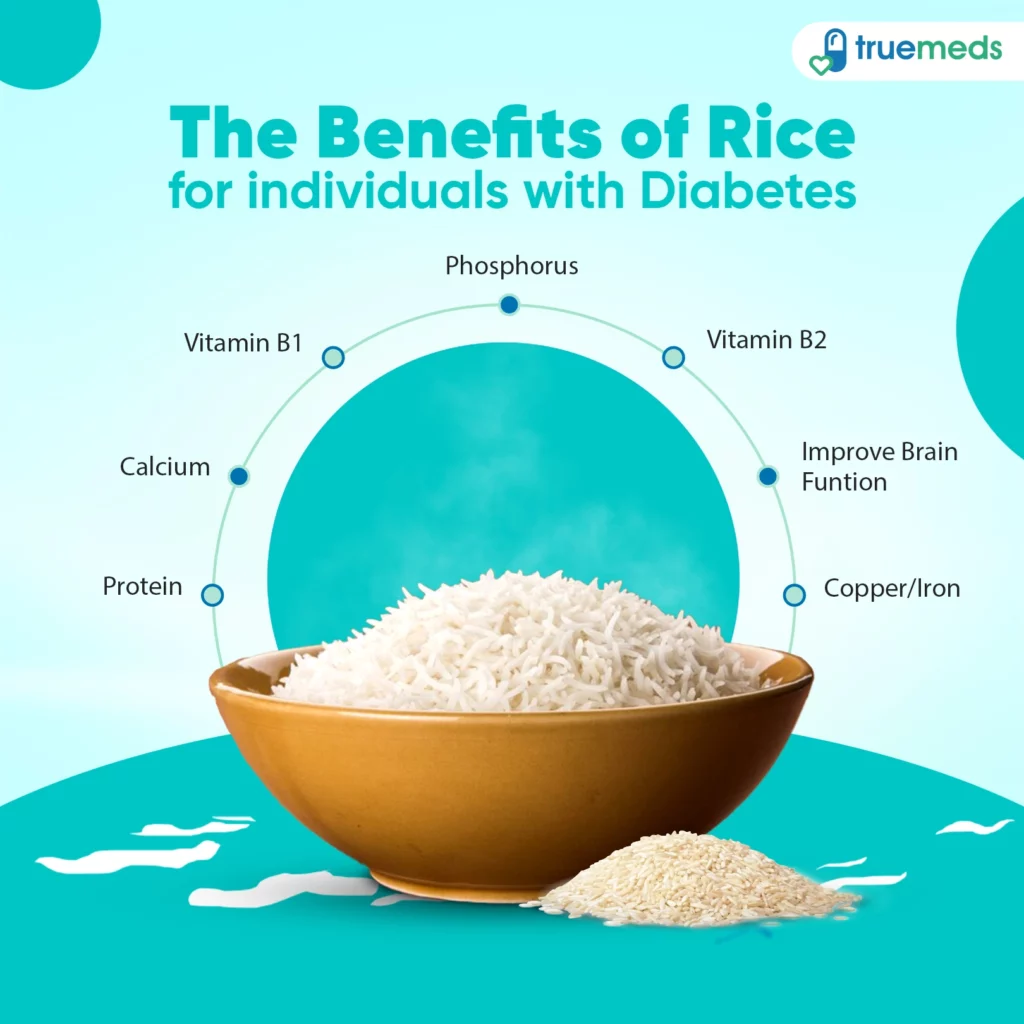Sugar-Free Rice for Diabetes Control
Last updated on : 01 Sep, 2024
Read time : 14 min
Rice has been an essential part of the diet in numerous cultures worldwide. However, the high carbohydrate content of rice can significantly impact blood sugar levels. The traditional starchy rice varieties are rich in simple carbohydrates that swiftly convert into glucose, increasing blood sugar levels.
Nonetheless, advancements in the food industry have introduced sugar free rice. It could be advantageous for individuals with diabetes who wish to include rice in their diet while maintaining stable blood sugar levels.
Sugar free rice is a rice variety with a lower glycemic index (GI) (it does not increase blood sugar levels when consumed). These rice varieties are often processed or modified to reduce their carbohydrate content or alter their starch rice structure, resulting in slower digestion and absorption.
This blog will delve into the different types of sugar free rice available, including brown rice, parboiled rice, and speciality rice varieties. It will explore their nutritional profiles, glycemic index values, and their impact on blood sugar levels. Additionally, it will provide insights into cooking methods, portion control, and incorporating sugar free rice for diabetics meal plans.
Rice for Diabetics
When considering rice for diabetics, opting for whole-grain varieties like brown rice is crucial. These types have a lower glycemic index, leading to slower blood sugar spikes. Cooking rice for diabetics involves techniques that can help reduce its impact on blood sugar levels.
What is Sugar-Free Rice?
Starch-free or sugar free rice refers to rice varieties specially processed to remove or significantly reduce the starch content. Starch is a carbohydrate found in rice that gets broken down into glucose during digestion, increasing blood sugar levels.
By reducing or eliminating the starch content, starch-free rice aims to provide an alternative for individuals who need to manage their blood sugar, such as those with diabetes or those following a low-carbohydrate diet.
The rice grains undergo a specialised treatment process that applies the removal of the outer layer, which is known to contain most of the starch content, to produce rice free from starch. It can be achieved by utilising various techniques such as parboiling, soaking or fermentation.
As a result of this process, the rice contains lower carbohydrate levels, reducing its impact on blood sugar levels. Compared to traditional rice varieties, this starch-free rice is a healthier alternative for individuals looking to manage their carbohydrate intake.
The Nutritional Value of Rice
To fully understand the nutritional value of rice, it’s essential to look closely at its excellent nutrient profile. The following details are of white rice, most commonly consumed in many cultures worldwide.
| Nutrient | Amount per 100g |
| Energy | 130 kcal |
| Carbohydrates | 28.2 g |
| Fibre | 0.4 g |
| Protein | 2.7 g |
| Fat | 0.3 g |
| Phosphorus | 43 mg |
| Sodium | 1 mg |
| Zinc | 0.3 mg |
| Potassium | 35 mg |
| Calcium | 10 mg |
| Iron | 0.4 mg |
| Magnesium | 12 mg |
Rice Glycemic Index
Regarding rice, the glycemic index can vary depending on the type. The white rice glycemic index is around 70 or more than brown rice or basmati rice. It means that after consuming white rice, there can be a rapid increase in blood sugar levels. The reason for this is due to the processing of white rice.
The outer bran and germ layers of white rice are removed during processing, which contains fibre and other nutrients that help slow down the absorption of carbohydrates. Therefore, consider choosing brown rice or basmati rice for a healthier option.
Also check- Coconut: A Superfood for Diabetes Management
Diabetes-Friendly Sugar-Free Rice Options
Maintaining stable blood sugar levels is of utmost importance for people with diabetes. The role of food choices in achieving this must be considered. White rice, a staple food in many cultures, can challenge people with diabetes due to its high carbohydrate content. But there’s good news. The following rice options suit people with diabetes and can be included in a well-rounded diet.
1) Brown Rice
Unlike white rice, brown rice sustains its external bran layer and germ, offering a more potent dose of fibre and nutrients. By incorporating fibre, digestion is decelerated, and glucose is released into the bloodstream steadily. It, in turn, helps to prevent sudden surges in blood sugar levels following a meal. Hence, it can be considered diabetes rice.
2) Wild Rice
Wild rice, also known as black rice, is classified as a seed, not a grain. Wild rice has a much lower glycemic index than white rice and is loaded with fibre, antioxidants, and essential minerals. Incorporating wild rice into your dishes can enhance the nutritional value and flavour with its nutty taste and chewy texture. Wild rice, or as we can call it, diabetes rice, is an excellent choice for healthy and enjoyable meals.
3) Cauliflower Rice
Cauliflower rice has become quite a sensation among health-conscious people. This diabetes rice, an alternative to traditional white rice, is prepared by finely chopping or grating cauliflower into rice-like pieces. It is a wise choice for those mindful of their carbohydrate intake, as it contains significantly fewer carbs and calories than the real deal. Therefore, it is a perfect fit for anyone on a low-carb diet.
4) Quinoa
While quinoa isn’t classified as rice, it bears a striking resemblance to a grain. It’s a fantastic alternative to rice, offering substantial protein, fibre, and essential vitamins and minerals. Additionally, quinoa has a lower GI than white rice, which makes it an ideal choice for individuals with diabetes.
Cooking Tips for Starch-Free Rice
To create tasty and diabetes-friendly meals, you can use some handy tips and techniques when cooking sugar-free rice. Keep these cooking tips in mind to achieve optimal results:
- Choose the proper rice: Consider incorporating rice varieties that are healthier for those with diabetes, such as brown rice, wild rice, cauliflower rice, or quinoa. These choices contain a lower glycemic index and more fibre, which assists in stabilising blood sugar levels.
- Rinse and soak rice: If you’re cooking brown rice or wild rice, rinse them thoroughly before cooking to remove any debris or excess starch. Soaking these types of rice for a few hours or overnight can also help improve their texture and reduce cooking time.
- Cook with portion control: Be mindful of your portions to keep a well-rounded carbohydrate intake. A trick to prevent overindulging in carbs is to measure the rice you cook for a meal. This way, you can confidently enjoy your dish without worrying about consuming too many carbs in one sitting.
- Add spices and herbs: Innovate by incorporating spices and herbs to aromatise your starch-free rice. Options like garlic, ginger, turmeric, cinnamon, or fresh herbs can add a burst of taste and provide potential health benefits.
- Practice cooking methods: Experiment with various cooking methods like steaming, boiling, or stir-frying, to prepare starch-free rice. These methods help retain the nutritional value and texture of the rice while adding variety to your meals.
- Use healthy cooking oils: To make your rice dishes healthier, consider swapping out healthy cooking oils for more nutrient-rich options like olive oil, sunflower oil, or coconut oil. By doing so, you’ll benefit from these healthier oils and avoid any negative impact on blood sugar levels from using oils high in saturated or trans fats.
The Benefits of Sugar-Free Rice for Diabetes

Rice, when consumed in moderation and with careful consideration, can offer several benefits for individuals with diabetes. Here are the key advantages to keep in mind:
1) Energy Source
Rice is a fantastic energy source as it contains a significant amount of carbohydrates, which are vital for fueling the body and keeping energy levels high all day. It is imperative to consume enough carbohydrates to maintain optimal performance and well-being.
2) Nutrient Content
Rice is a staple food rich in carbohydrates, providing energy to the body. It contains essential nutrients such as B-complex vitamins (especially B1 and B3) and minerals like iron, magnesium, and phosphorus. Brown rice, a whole grain option, retains more nutrients due to its bran and germ layers. However, refined white rice loses some of its nutrients during processing. While rice is a good energy source, incorporating a variety of nutrient-dense foods is important for a balanced diet.
3) Fibre Content
Brown rice and other similar varieties are known to have a greater quantity of dietary fibre than refined white rice. This fibre content can be particularly advantageous for those living with diabetes, as it has been shown to assist in controlling blood sugar levels. Additionally, fibre can help promote feelings of fullness and contribute to overall digestive health.
4) Glycemic Index Consideration
While white rice has a higher GI, other options, such as brown rice, wild rice, or basmati rice, have a lower GI. By selecting rice with a lower GI, you can effectively avoid sudden surges in blood sugar levels, thus maintaining your overall health and well-being.
5) Versatility in Meal Planning
Rice is a global ingredient that can be included in various meal plans and cuisines. It can serve as a base for stir-fries, grain bowls, side dishes, or desserts. Its versatility allows for flexibility in meal planning and helps create balanced and satisfying meals.
Conclusion
Rice for diabetics requires careful consideration due to its impact on blood sugar. Sugar free rice can be an excellent option for individuals with diabetes or those looking to maintain stable blood sugar levels. The different varieties of sugar free rice, such as brown rice, parboiled rice, and speciality rice, offer various nutritional benefits and can be included in a balanced and healthy diet.
While these rice varieties may not taste the same as traditional rice, they provide a healthier alternative to help individuals better manage their blood sugar levels. With progress in the food industry, we can look forward to even more options and improvements in sugar free rice varieties.
You can download our user-friendly Truemeds app for easy access to medicine at low rates. Submit your prescription to our platform to receive branded and generic medications. Enjoy savings on purchases and the added convenience of free home delivery on relevant orders across India*.
Frequently Asked Questions
Different rice has varying effects on blood sugar levels. Refined white rice tends to cause a more rapid increase in blood sugar compared to whole-grain options like brown rice, wild rice, or basmati rice. These options have a lower glycemic index (GI) and can help regulate blood sugar levels more effectively.
The impact of cooked rice on weight management and overall health in diabetic individuals depends on portion sizes and dietary choices. Moderation is essential, as consuming large quantities of rice, significantly refined varieties, can contribute to weight gain and potentially impact blood sugar control.
The recommended daily intake of white rice for individuals with diabetes can vary depending on individual factors such as age, weight, activity level, and overall health. Limiting the portion size and choosing whole-grain rice options or alternatives with a lower GI whenever possible is generally advised.
Consuming rice, particularly refined white rice, can increase blood sugar levels due to its higher carbohydrate content. However, factors such as portion size, cooking method, and the type of rice chosen (e.g., whole grain, basmati rice) can influence the extent of the increase.
Both rice and roti can be a part of a balanced diet for diabetic individuals. However, whole grain roti or whole wheat bread generally has a lower GI than white rice, making it more suitable for managing blood sugar levels. It’s important to consider portion sizes and balance the meal with other nutritious foods such as vegetables, proteins, and healthy fats.
Boiled rice, mainly made from whole-grain varieties like brown rice or wild rice, can contain some dietary fibre. However, the fibre amount may be lower than the unprocessed whole-grain versions.
While certain types of rice, such as brown rice or wild rice, contain dietary fibre, rice is not usually considered a significant source of fibre. Individuals with diabetes are encouraged to obtain dietary fibre from other sources such as whole grains, legumes, fruits, vegetables, and nuts for better overall fibre intake.
Among the different types of rice, basmati rice has a relatively lower glycemic index (GI) than other varieties. Brown basmati rice, in particular, tends to have a lower GI than white basmati rice.
Rice naturally contains small amounts of sugar, mainly in the form of glucose. The sugar content varies depending on the type of rice and its processing. However, rice is not typically considered a significant source of added sugars compared to other carbohydrate-rich foods.
For diabetic patients, choosing whole grain rice options like brown rice, wild rice, or basmati rice is generally recommended. These types of rice have a low glycemic index (GI) than white rice, meaning they have a slower impact on blood sugar levels.
Basmati rice is almost sugar-free. Unlike other types of rice, it has a low glycemic index, making it suitable for people with diabetes. However, it’s essential to consume it in moderation due to its carbohydrate content
Basmati rice is one of the rice varieties low in sugar. Its low glycemic index makes it suitable for people with diabetes, but it’s essential to consume it in moderation due to its carbohydrate content .
Starch-free rice is a healthier alternative for people with diabetes. By reducing or eliminating starch content, it helps manage blood sugar levels. Cooking rice in a starch-free way and cooling it can further control blood glucose rise. Remember to pair it with nutrient-dense foods like vegetables for a balanced meal.
Disclaimer
The content provided within this article has been thoroughly verified for accuracy. However, we advise consulting a doctor before utilising any medication or dietary supplements mentioned herein.
References
- Sun Q, Spiegelman D, van Dam RM, Holmes MD, Malik VS, Willett WC, Hu FB. White rice, brown rice, and risk of type 2 diabetes in US men and women. Archives of internal medicine. 2010 Jun 14;170(11):961-9. [Cited 2023 June 27]. Available from: https://www.ncbi.nlm.nih.gov/pmc/articles/PMC3024208/
- Hu EA, Pan A, Malik V, Sun Q. White rice consumption and risk of type 2 diabetes: a meta-analysis and systematic review. BMJ. 2012 Mar 15;344. [Cited 2023 June 27]. Available from: https://www.ncbi.nlm.nih.gov/pmc/articles/PMC3307808/
- Yu J, Balaji B, Tinajero M, Jarvis S, Khan T, Vasudevan S, Ranawana V, Poobalan A, Bhupathiraju S, Sun Q, Willett W. White rice, brown rice and the risk of type 2 diabetes: a systematic review and meta-analysis. BMJ open. 2022 Sep 1;12(9):e065426. [Cited 2023 June 27]. Available from: https://www.ncbi.nlm.nih.gov/pmc/articles/PMC9516166/
- Malik VS, Sudha V, Wedick NM, RamyaBai M, Vijayalakshmi P, Lakshmipriya N, Gayathri R, Kokila A, Jones C, Hong B, Li R. Substituting brown rice for white rice on diabetes risk factors in India: A randomised controlled trial. British Journal of Nutrition. 2019 Jun;121(12):1389-97. [Cited 2023 June 27]. Available from: https://www.ncbi.nlm.nih.gov/pmc/articles/PMC6948352/
- Rice, white, long-grain, regular, unenriched, cooked without salt. [Internet]. [Cited 2023 June 27]. Available from: https://fdc.nal.usda.gov/fdc-app.html#/food-details/169757/nutrients
Disclaimer
Our healthcare experts have carefully reviewed and compiled the information presented here to ensure accuracy and trustworthiness. It is important to note that this information serves as a general overview of the topic and is for informational purposes only. It is not intended to diagnose, prevent, or cure any health problem. This page does not establish a doctor-patient relationship, nor does it replace the advice or consultation of a registered medical practitioner. We recommend seeking guidance from your registered medical practitioner for any questions or concerns regarding your medical condition.
Popular Articles
Recommended Articles
Recent Articles
Top-Selling Medicines:
...View more
Top-Selling OTC:
...View more
Subscribe
Claim your complimentary health and fitness tips subscription and stay updated on our newest promotions.
Download Truemeds
Manage your health with ease Download Truemeds today!Get easy access to medicine refills, health information, and more. With our app, you'll never have to wait in line again. Download now and start taking control of your health.

Contact Us
Our customer representative team is available 7 days a week from 9 am - 9 pm.
v3.5.0
Our Payment Partners



























































